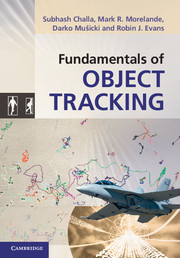Book contents
- Frontmatter
- Contents
- Preface
- 1 Introduction to object tracking
- 2 Filtering theory and non-maneuvering object tracking
- 3 Maneuvering object tracking
- 4 Single-object tracking in clutter
- 5 Single- and multiple-object tracking in clutter: object-existence-based approach
- 6 Multiple-object tracking in clutter: random-set-based approach
- 7 Bayesian smoothing algorithms for object tracking
- 8 Object tracking with time-delayed, out-of-sequence measurements
- 9 Practical object tracking
- Appendix A Mathematical and statistical preliminaries
- Appendix B Finite set statistics (FISST)
- Appendix C Pseudo-functions in object tracking
- References
- Index
4 - Single-object tracking in clutter
Published online by Cambridge University Press: 07 September 2011
- Frontmatter
- Contents
- Preface
- 1 Introduction to object tracking
- 2 Filtering theory and non-maneuvering object tracking
- 3 Maneuvering object tracking
- 4 Single-object tracking in clutter
- 5 Single- and multiple-object tracking in clutter: object-existence-based approach
- 6 Multiple-object tracking in clutter: random-set-based approach
- 7 Bayesian smoothing algorithms for object tracking
- 8 Object tracking with time-delayed, out-of-sequence measurements
- 9 Practical object tracking
- Appendix A Mathematical and statistical preliminaries
- Appendix B Finite set statistics (FISST)
- Appendix C Pseudo-functions in object tracking
- References
- Index
Summary
In Chapters 2 and 3, we introduced state estimation and filtering theory and its application to idealistic object tracking problems. The fact that makes practical object tracking problems both challenging and interesting is that the sensor measurements, more often than not, contain detections from false targets. For example, in many radar and sonar applications, measurements (detections) originate not only from objects of interest, but also from thermal noise, terrain reflections, clouds, etc. Such unwanted measurements are usually termed clutter. In vision-based object tracking, where tracking can be used to count moving targets, shadows created by an afternoon sun, light reflections on snow or the movement of leaves on a tree can all generate clutter data in the images.
One of the defining characteristics of clutter or false alarms is that their number changes from one time instant to the next in a random manner and, to make matters worse, target- and clutter-originated measurements share the same measurement space and look alike. Practical tracking problems are considerably difficult since sometimes, even when there are targets in the sensor's field of view, they can go undetected or fail to appear in the set of measurements. In other words, true measurements from the target are present during each measurement scan with only a certain probability of detection. Hence, determining the state of the object using a combination of false alarms and true target returns is at the heart of all practical object tracking problems and is the subject of this chapter.
Information
- Type
- Chapter
- Information
- Fundamentals of Object Tracking , pp. 103 - 132Publisher: Cambridge University PressPrint publication year: 2011
